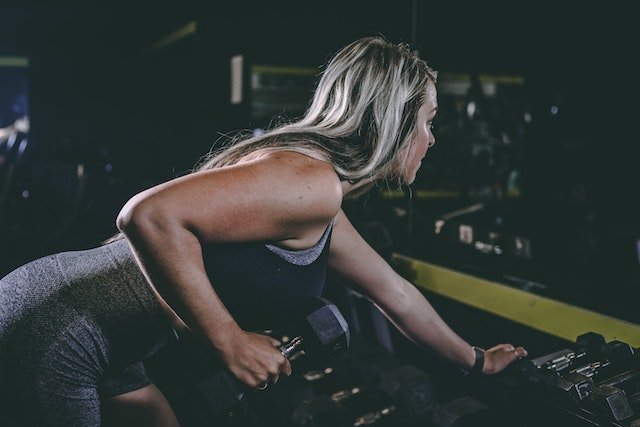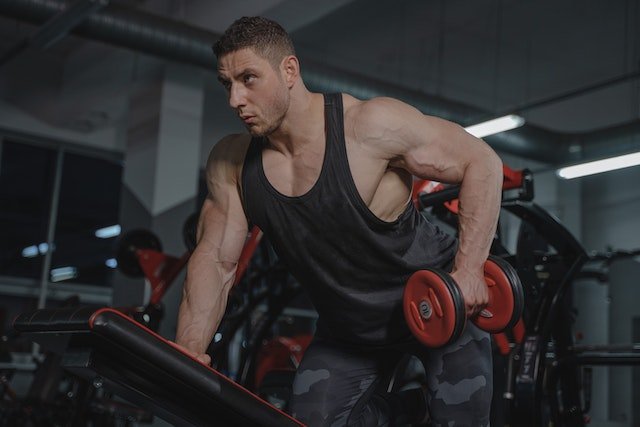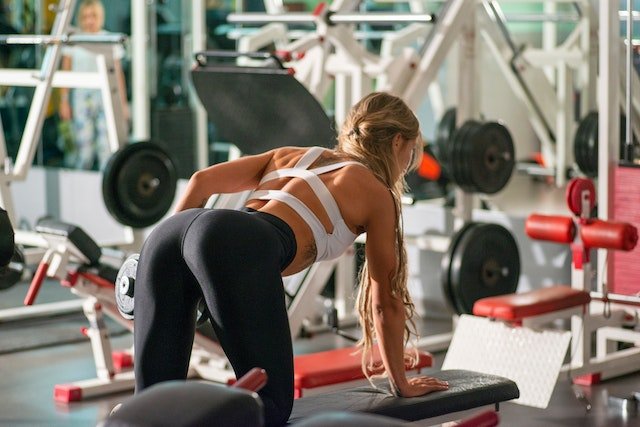Don’t Feel Dumbbell Rows In Your Back? 10 Vital Pointers For Better Results
Dumbbell rows are a great exercise for targeting your back muscles and are popular among bodybuilders and fitness enthusiasts alike.
However, some people find that they don’t feel the exercise in their back muscles, but instead feel it in their biceps or shoulders.
There are a few possible reasons for this and it’s worth looking into so you can get the most out of this exercise.
With a little bit of modification, you can make sure that you’re targeting your back muscles correctly and feeling the exercise where it’s supposed to be felt.
Don’t Feel Dumbbell Rows in Your Back?
There are a couple of reasons why you might not feel dumbbell rows in your back. First, if you’re pulling incorrectly, you won’t be able to effectively target your back muscles. Second, if you’re using too much weight, you may be relying more on momentum than muscle power to get the weights up. Third, if you’re not using proper form, you may be using other muscles (like your biceps) more than your back muscles. Fourth, if you aren’t keeping your elbows tucked in and leading with them when lifting, you won’t target your latissimus dorsi muscles properly. Finally, if you have range of motion issues or are rounding your back to lift the weight, these are reasons you won’t feel rows in your back. If you still aren’t feeling the exercise correctly seek the advice of a personal trainer to help you with your form.
Rows are a great exercise for targeting the back muscles, but only if you’re doing them correctly. If you’re not feeling the exercise in your back, there are a few possible reasons why. First, make sure you’re using proper form.
Incorrect pulling angle
When pulling the dumbbell towards your body, it should be closer to your waist than your chin.
This ensures that you’re using your back muscles and not your biceps.
You see it time and time again in the gym where people are yanking the dumbbell up towards their chest with vigour, but the whole movement just looks off.
When you pull the weight towards your waistline, it is activating the correct muscles and ensures the latissimus dorsi are being worked.
When lifting anything particularly heavy, our body will naturally adjust itself to get the job done and dumbbell rows are no exception.
With this exercise, your body will automatically pull higher up your body if the weight is too heavy for you.
So take time to lift the dumbbell towards your waistline and see if that helps you feel the exercise in your back.

Keep elbows tucked in and lead with them
When rowing the dumbbell up, ensure your elbows are tucked in and you’re leading with them.
This allows you to better target the latissimus dorsi muscles.
If you keep your elbows flared out, you put unnecessary stress on the shoulder joint and won’t feel the row as much in your back.
Instead, keep your elbows tucked in and use them to lead the weight up. This will help you target your back muscles more effectively.
Just as you do with the lat pulldown, where you aren’t necceceraly pulling the bar with your hands but pulling the bar more from your elbows parallel towards the ground to feel the correct muscle activation.
The dumbbell row is the same in that you lead the movement with your elbow while keeping it tucked firmly beside your body without flaring it out to the side like a clucking chicken flapping its wings.
Some people remove their thumbs from the equation, making them hold the bar with a monkey grip which can help force you into pulling the dumbbell up correctly.
Using the thumb can sometimes encourage you to use your biceps more with the fact you are gripping the bar and focusing on that instead.
Poor form
When rowing the dumbbell, people often yank it up at pace and twist their torso at the top of the movement in order to get the dumbbell up, rather than using their back muscles.
When lifting a heavy dumbbell, people tend to snatch at it and rush the movement, rather than using a controlled tempo.
This puts unnecessary strain on your so many different muscle groups and takes the focus away from your back muscles.
Instead, use a controlled tempo and focus on using your back muscles to lift the weight with your elbow tucked firmly in by your side.
In some cases, people will also round their back when rowing the dumbbell up. This is a big no-no and can lead to injury.
When rowing the dumbbell up, ensure you have a slight arch in your back and that you’re not rounding it.
This will help you avoid injury and ensure you’re using your back muscles correctly.
Related: Why Do I Feel Lat Pulldowns In My Forearms? All The Answers Here
Gripping too tight
If you’re gripping the dumbbell too tight, you may be inadvertently using your biceps more than your back muscles.
To avoid this, ensure you’re using a firm grip on the dumbbell. This will help you focus on using your back muscles and not your biceps.
Also, when gripping the bar too tight it will inevitably encourage poor form during the movement as your body tenses up due to the grip.
A tight grip leads to tension and tension can lead to injury, so ensure you have a relaxed grip on the dumbbell to help avoid this.
Loosen your grip and let the weight do the work as you focus on contracting your back muscles.
Tension
If you are too tense when performing any exercise or movement, you are more likely to injure yourself.
This is because your muscles aren’t able to work as effectively and your range of motion is reduced.
When performing dumbbell rows, ensure you’re not too tense. This will help you avoid injury and ensure you’re using your back muscles correctly.
If you are too tense, you aren’t going to feel the movement in your back as you will be foscused on wherever the tension is.
To avoid tension, focus on using a controlled tempo and ensure you’re not gripping the dumbbell too tight.
If you have range of motion issues, you may not be able to effectively target the correct muscles.
This is because you won’t be able to lower the dumbbell as far down or lift it to the correct position.
Also, make sure you are warming up properly before performing the movement. As this will allow for greater range of motion and your muscles will be warmed up to better perform the exercise.
Flat or angled bench
When performing dumbbell rows, you can either use a flat bench or an angled bench.
Both are effective but using an angled bench will help you target your back muscles more effectively.
The angle of the bench means you have to work harder to row the weight up, which means your back muscles have to work harder too.
If you are using a flat bench, make sure you keep your chest up and shoulders back to ensure you are engaging your back muscles.
You might also want to think about placing your feet on a box or elevated surface to help you keep your back flat.
This will help you avoid rounding your back, which we will come to shortly.

Dropping head
When some people row the dumbbell up, they have a tendency to drop their head down and look at their chest.
This puts unnecessary strain on your neck and takes the focus away from your back muscles.
Instead, keep your head up and in line with your spine. This will help you focus on using your back muscles and avoid injury.
Related: Why Are My Pull Ups Decreasing? All You Need To Know For Better Results
Rounding back and shoulders
When some people row the dumbbell up, they have a tendency to round their shoulders.
Rounding your shoulders takes the focus away from your back muscles and puts unnecessary strain on them.
To avoid this, focus on using a weight that’s manageable and ensure you keep your back and shoulders in alignment.
The same can be said for arching your back too much. If you are lifting a weight that’s too heavy, your body will naturally compensate to get the job done.
This too will put extra strain on your back and take the focus away from your back muscles.
keep your shoulders back and down and maintain a slight arch in your lower back throughout the movement.
It’s always good working practice to be able to see how you look in a mirror to make sure you are rowing the weight up in a straight line and not rounding your shoulders are arching your back, but make sure it’s not at the expense of pulling a muscle to see.
Weight
If you’re using too much weight, you may be relying more on momentum than muscle power to get the weights up.
Use a weight that’s manageable and focus on using your back muscles to lift the weight, this will help you build strength in your back and avoid injury.
We have mentioned quite a few times already about weight when it comes to rowing the dumbbell, but on the flip side, you might not be using enough weight!
This is highly unlikely, as we always instinctively try to lift too much, but there might be times when you have come back from an injury or you aren’t that confident in your ability to lift the weight, which means you go the other way and back away from the weight.
If this is the case maybe think about increasing the number of reps you are doing with a lighter weight, which will help build your confidence back up.
Scapula connection
When performing dumbbell rows, you want to ensure your scapula (shoulder blade) is moving.
Your scapula should move up and down as you row the weight up and back down.
If your scapula isn’t moving, it means you’re not using your back muscles correctly.
Focus on raising your elbows to move the weight, rather than your arms and you will feel your scapula move.
You should also focus on keeping your shoulders down and back, which will help you engage your back muscles.

Visualise the movement
This might sound a little out there but…have you thought about visualisation?
When you are performing the movement, focus on what your back muscles are doing.
This is also known as the mind-muscle connection, and it can be a really effective way of making sure you are engaging the right muscles.
This will help you focus on using your back muscles, rather than other muscles in your body.
It takes a bit of practice to get used to but once you have, it will help you feel the movement in your back.
You should also focus on keeping your breathing under control.
Breathe in as you row the weight up and breathe out as you lower it back down.
This will help you keep your core engaged and avoid injury.
Final Thoughts…
If you’re still struggling to feel rows in your back, it might be worth checking your form and technique.
There could be a number of reasons why you’re not feeling the movement in your back.
But, if you focus on using the right weight, keeping your shoulders down and back, and engaging your scapula, you should start to feel the movement in your back.
It might also be worth thinking about the mind-muscle connection and visualising the movement to help you focus on using your back muscles.
Remember to breathe and focus on using your back muscles to lift the weight.
If you are still struggling, it might be worth seeking professional advice from a qualified personal trainer or strength and conditioning coach who can help you with your technique.
Have your dumbbell rows suffered recently, did you get back on track? Let me know in the comments section below.


